Tuesday 18th January 2022
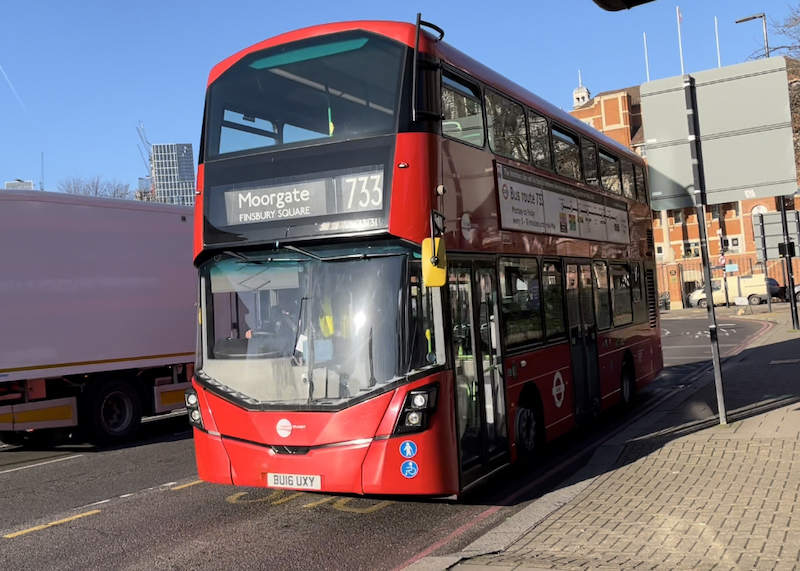
The last time I used “London’s newest bus route” as a title for a blogpost was on 29th March 2021 heralding the arrival of new route 456 in north London. Almost ten months on I’ve taken another ride on the route to see how it’s getting on but before that another new bus route began yesterday – the 733 between Oval and Moorgate providing cover for the temporary closure of the Northern Line’s City branch for the Bank Capacity Upgrade Programme.
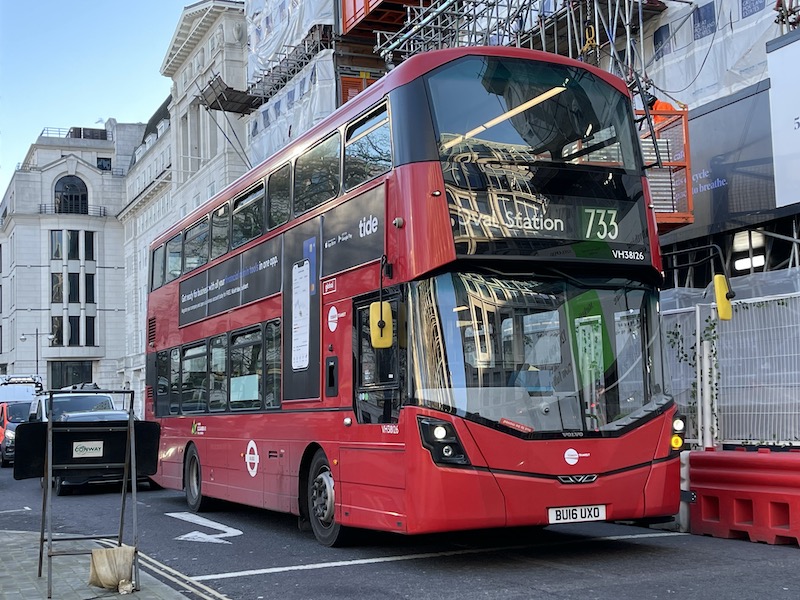
Oddly the route only runs Mondays to Fridays and is operated by Tower Transit on a 5-8 minute daytime frequency (7-10 minutes in the evenings). It’s nice to see the six year old Volvo hybrid buses being used are equipped with nearside posters promoting the route, but I have to admit I didn’t notice them until I looked at the photographs I’d taken later. It’s not exactly high profile route branding but it’s somewhat revolutionary for London I suppose.
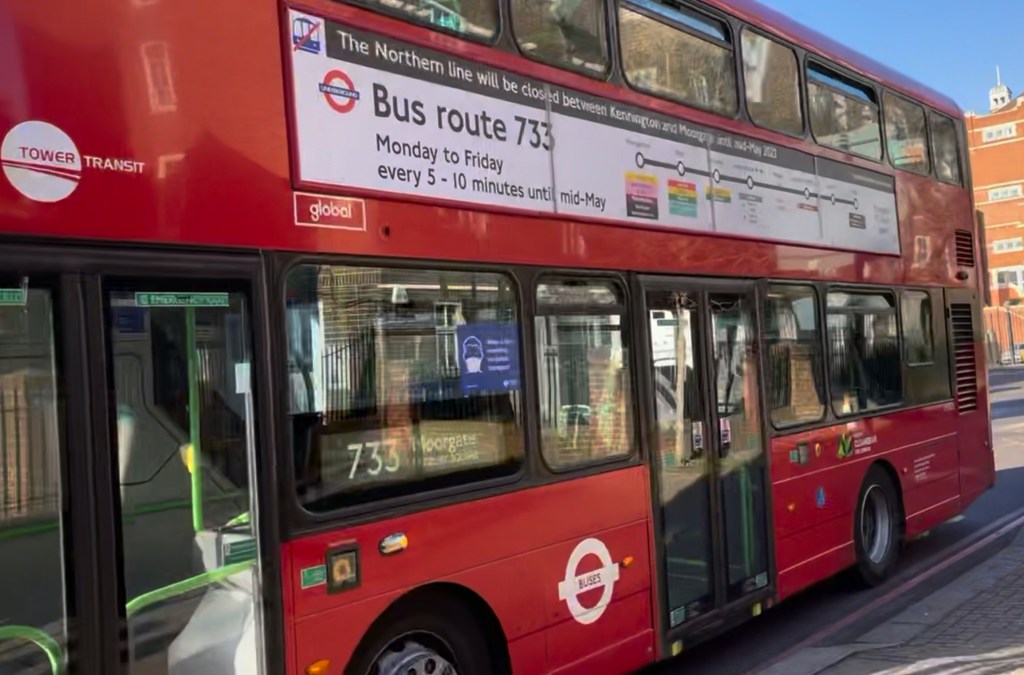
Three things struck me as I took a ride up and down the route yesterday morning.
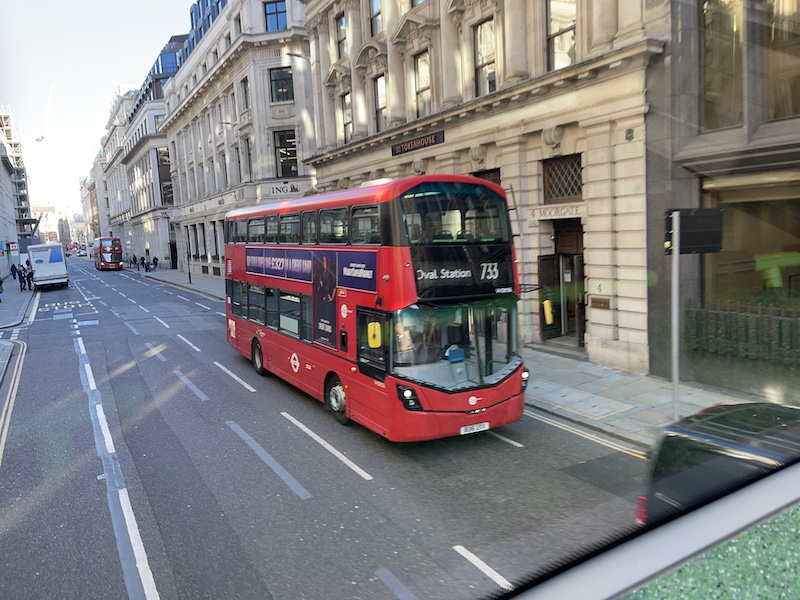
Despite what’s implied by those side adverts I was surprised route 733 stops as required at all bus stops along the route. As a rail replacement service I’d just wrongly assumed, like on National Rail, it would run non stop between stations to minimise inconvenience for displaced Underground passengers and provide a quicker journey. It takes between 20 and 25 minutes end to end, which isn’t bad, but is double the 10 minutes Northern line trains would take were they running.
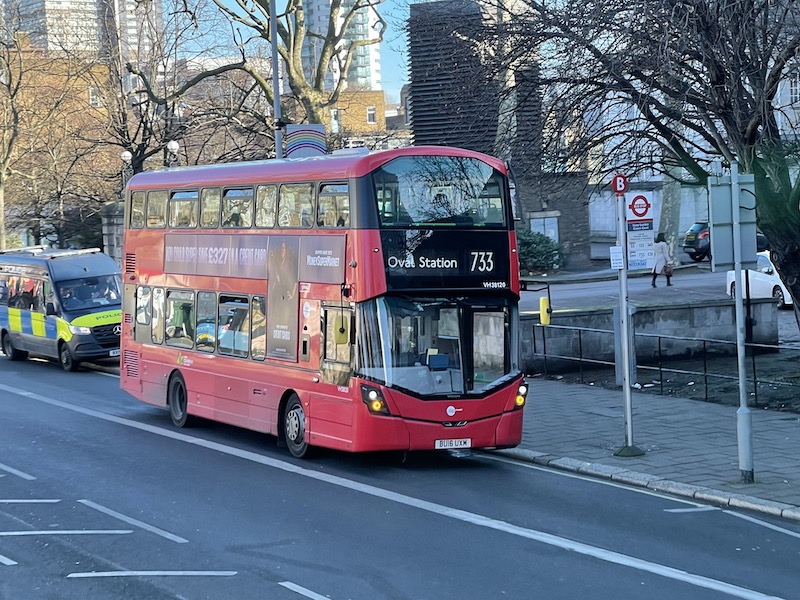
Secondly I was surprised it wasn’t free to use. Northern Line passengers travelling from, say High Barnet to London Bridge and opt to take the Tube as far as it currently goes, ie Moorgate, and then catch the 733 to complete their journey to London Bridge will end up paying £1.55 more (on the 733) for the dubious pleasure of having a disrupted and longer journey – their fare previously being the same to Moorgate as it is to London Bridge on the Tube, both being in zone 1. This hardly seems fair.
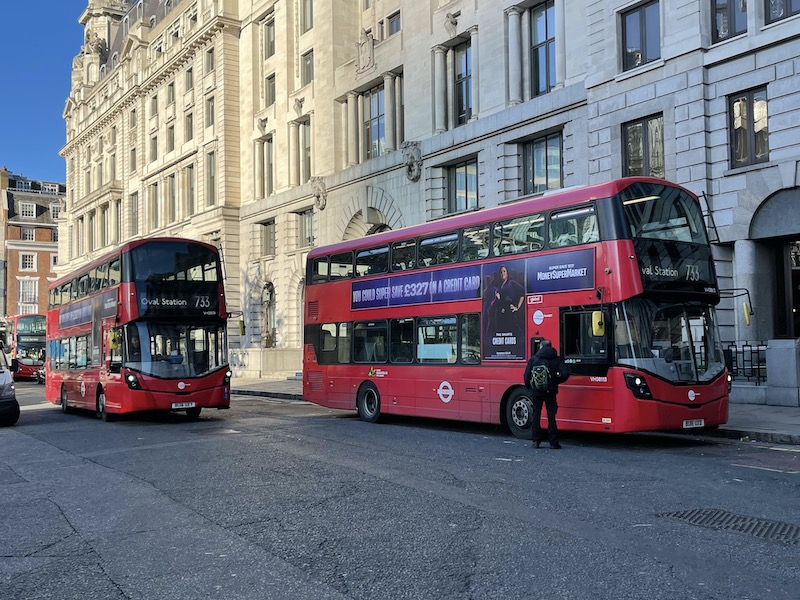
Thirdly, perhaps not quite so surprising, was to see how much resource TfL are throwing at this with what seemed like a generous running time allowance (I saw many buses waiting time along the route with hazard lights flashing); the usual generous stand time allowance at Oval and Moorgate termini; and a plethora of high-viz wearing Customer Information staff at every bus stop by the affected Underground stations and at the entrances to the closed stations.

I’m sure they mean well, but must be bored out of their minds.


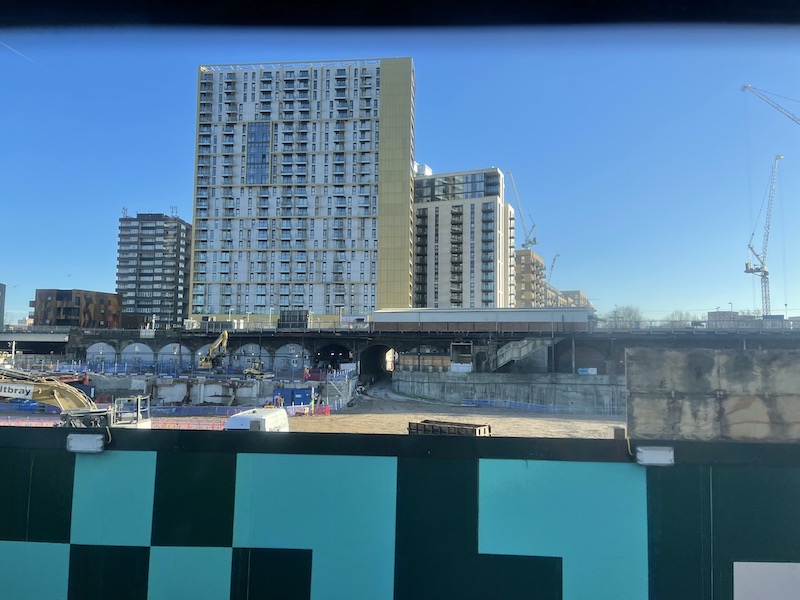
I suppose a fourth observation was the low number of passengers travelling (check out the photos of buses on this blog) indicating TfL’s pre closure information campaign has been successful. Most seemed to be using the bus to travel to and from stops along the route irrespective of the closed stations and where there are alternative bus routes available. Very few seemed to be boarding and alighting at the actual station stops.
However more positively it was good to see all the bus stop flags along the route had been updated with a 733 tile added …
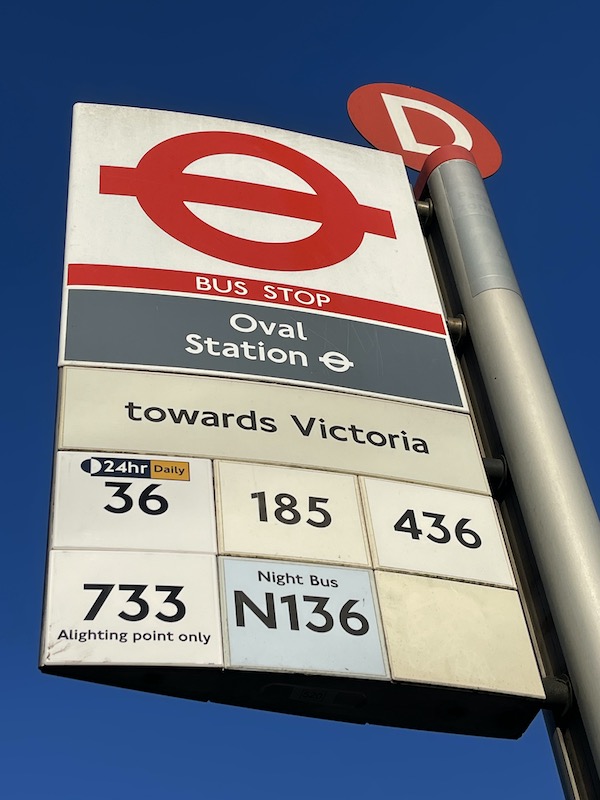
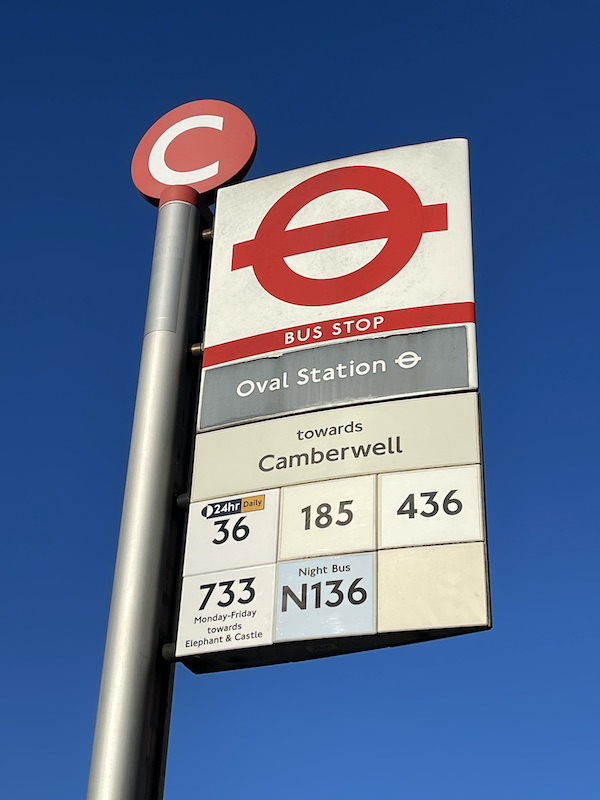
…. and timetable cases contained a yellow poster about the route ….
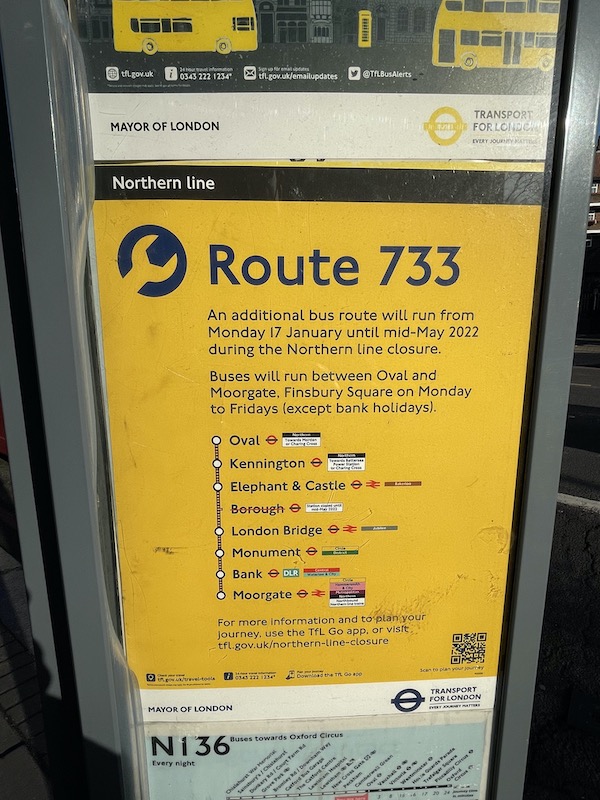
…. and timetable/frequency details.

London Underground have produced two printed leaflets explaining alternative travel options during the closures.
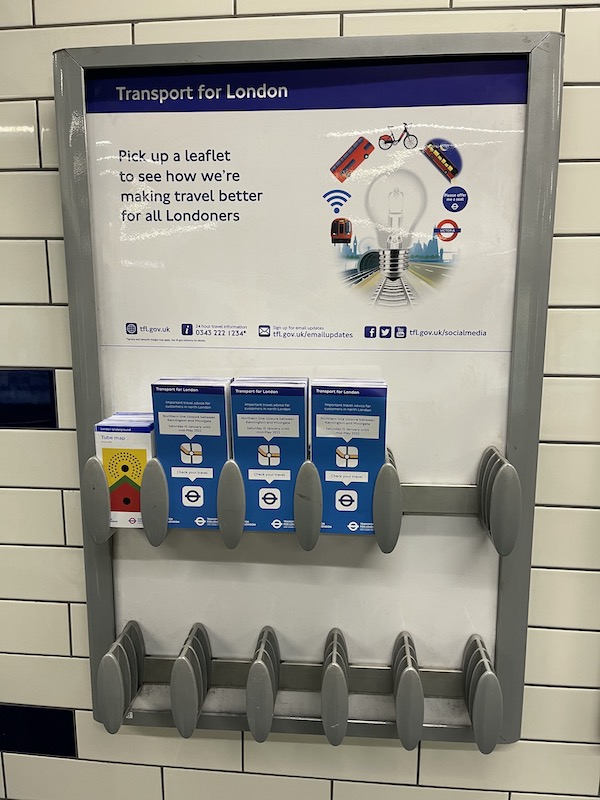
One for those travelling from north of the closure and one from the south. It was good to see supplies of these available in appropriate stations.

Posters are also displayed in prominent locations at the stations too with bespoke wording for each location.
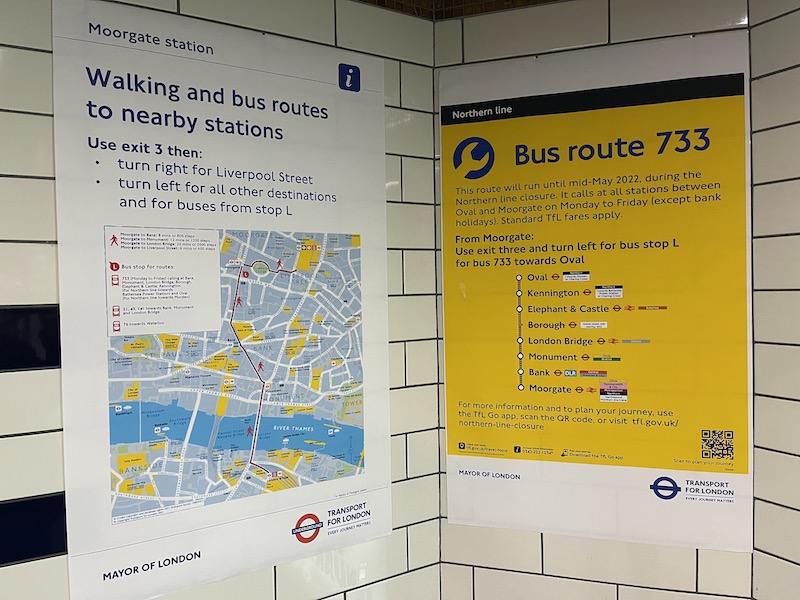
But I’m surprised, bearing in mind it’s vast resources, TfL’s proof checking standards are as bad as mine.
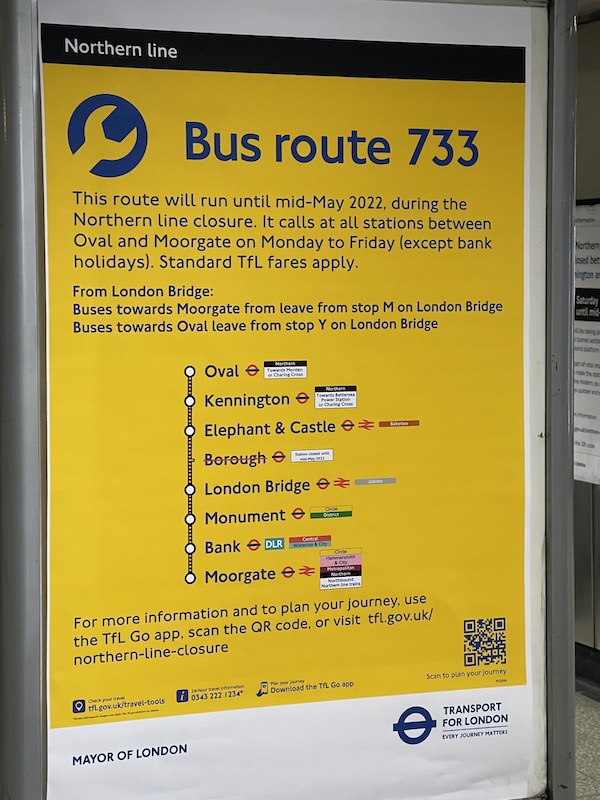
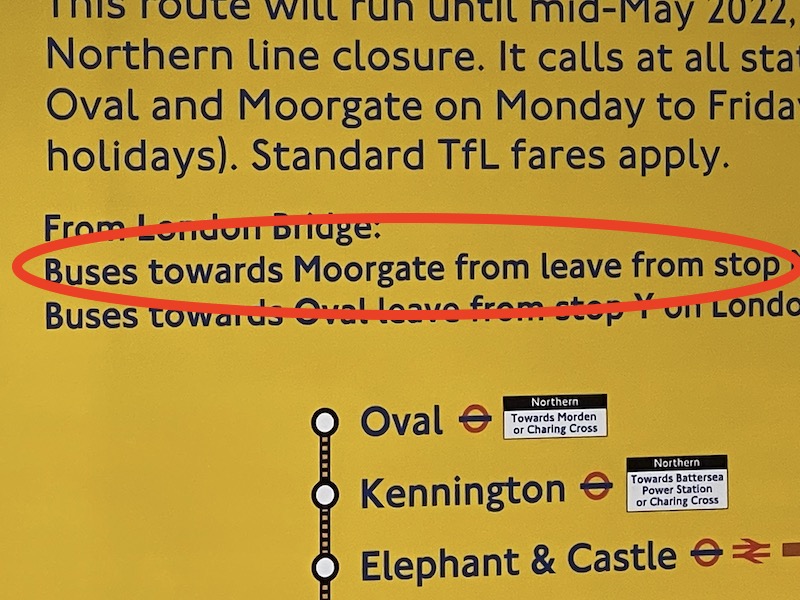
And that sloppiness also applies to the detail of the information provided.
For example as route 733 only runs on Mondays to Fridays, at weekends passengers are advised to use route 133 as an alternative.

Except route 133 doesn’t serve Moorgate so any passenger unfamiliar with TfL’s bus routes thinking they could catch it and arrive at Moorgate station will be disappointed (it goes to Liverpool Street as any schoolboy or schoolgirl person bus spotter knows).

At Moorgate weekend passengers would have been better advised to catch route 21 for Bank, London Bridge and Borough, where a change to a 133 for Elephant & Castle and Kennington would be needed but that doesn’t come over quite so simple as to catch one route I suppose.
Maybe TfL staff’s lack of detailed bus knowledge is not helped by there being no bus map? Just a thought.

The advice in the two leaflets is bland at best and somewhat puzzling in places.
Both leaflets have the same wording for the most part with the second column giving bespoke advice for either south or north London and a different map on the back.
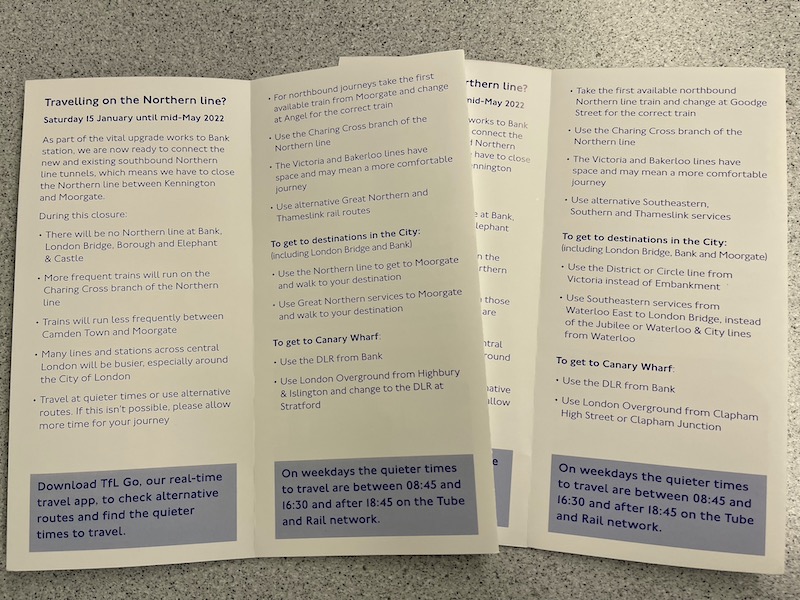
The North London leaflet (pictured on the left) advises “take the first available train from Moorgate and change at Angel for the correct train”. Why? That’s just nonsensical as the self same trains heading north will be at Angel, two stops further up the line, as at Moorgate.
The South London leaflet is equally perverse by advising passengers to change trains at Goodge Street. But why? If it’s to reach KIngs Cross and the City, it would be better to continue to Warren Street and change to the Victoria Line for the former and continue to Euston and change for Angel, Old Street and Moorgate for the latter. Or indeed change at the previous stop at Tottenham Court Road for the Central Line to Bank, but I appreciate they might be trying to avoid overcrowding on that line, but changing at Goodge Street is not going to help in any way. And oddly the map in the South London leaflet only extends as far north as Tottenham Court Road and doesn’t even show Goodge Street which would certainly flummox anyone unfamiliar with the Underground network.

Information about route 733 on TfL’s website is also inaccurate.

Details are given of bus stops served including the very first bus stop (lettered K) as buses leave the Finsbury Square, Moorgate terminus. You even get real time information about upcoming departues.
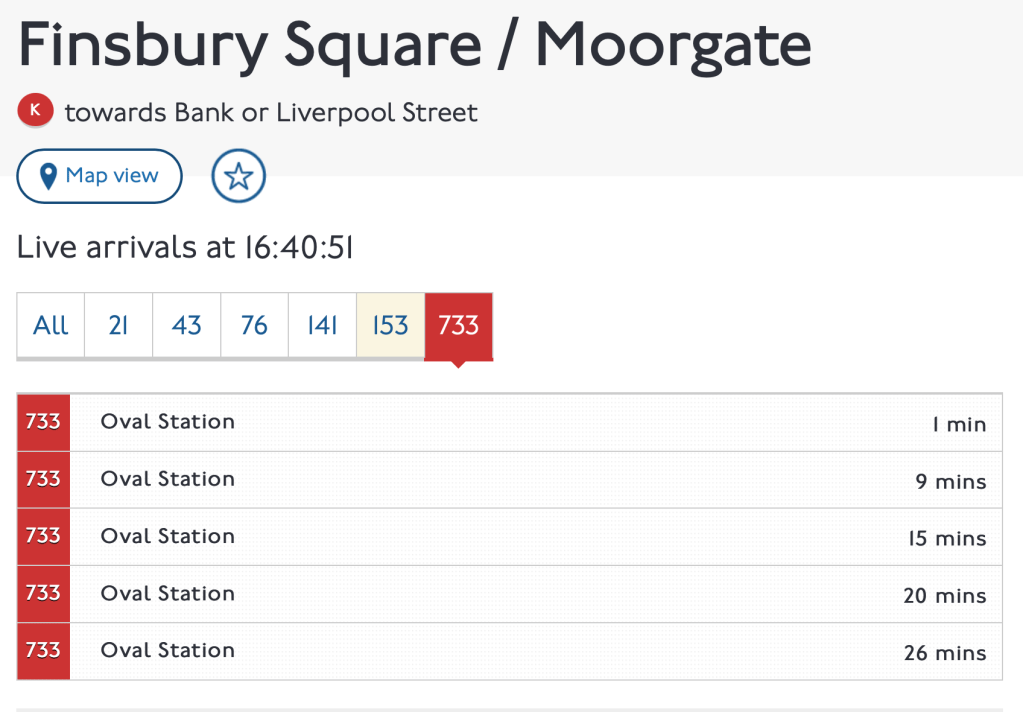
Except, bus stop K has been closed for many weeks with no alternative provided.

I’m surprised neither of the two leaflets gives much prominence to route 733 bearing in mind the huge cost of laying it on. It’s being run from Tower Transit’s garage at Lea Interchange which must be over five miles from Moorgate entailing considerable dead running for driver reliefs and reportedly with a PVR of 15 buses so that won’t come cheap – around three quarters of a million for the next four months I reckon although in a project costing £655 million I suppose it’s all relative. But Tower Transit have done well to get the route up and running in the current circumstances of staff shortages – it must take around 40 drivers and some dedicated supervisory staff too.
After my 733 experience I headed on to north London to take a ride on the ten month old route 456 – the previous holder of the ‘London’s newest bus route’ accolade.
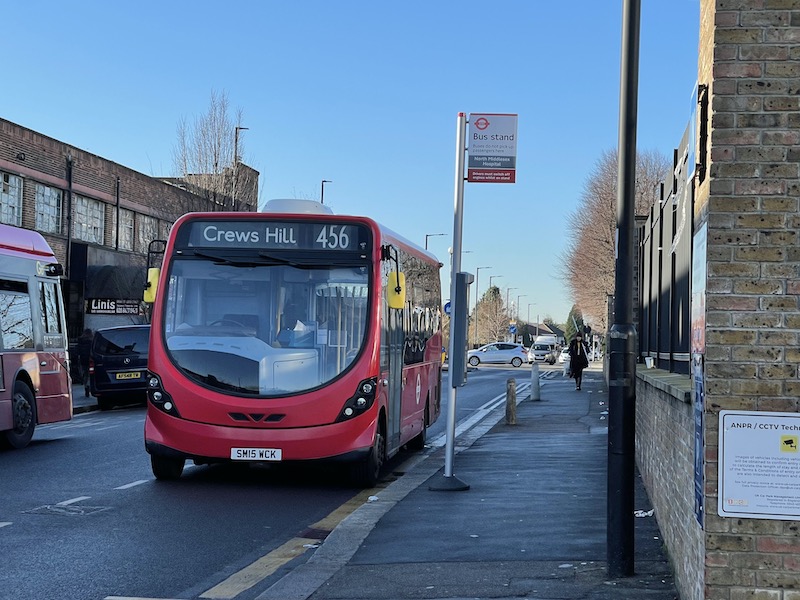
I rode the 12:27 journey from North Middlesex University Hospital to Crews Hill.
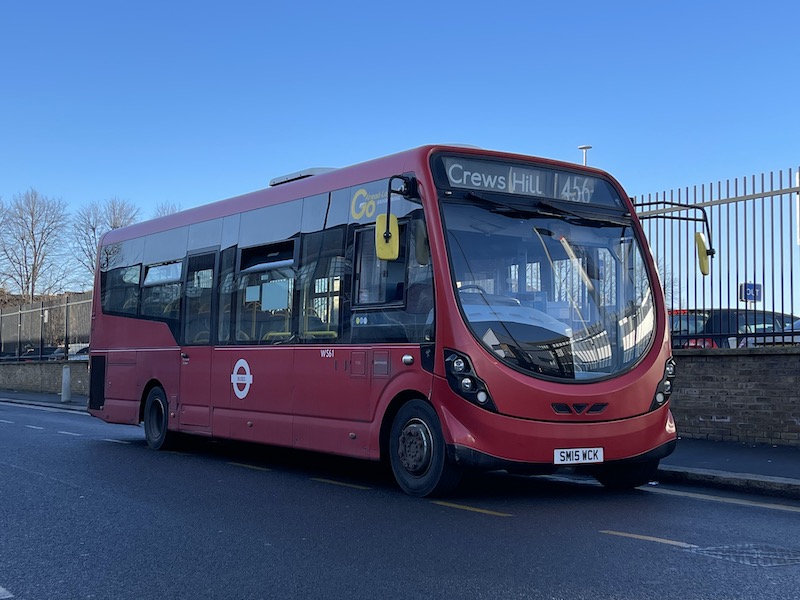
Setting off with no one else on board we picked up a passenger at the first stop who travelled to Farm Road in Winchcmbe Hill (a journey which previously entailed two buses) and at the next stop in Silver Street two adults with two young people all travelling together also boarded for Farm Road where they were going to the nearby school. Another passenger boarded in Church Hill travelling to Highlands School in Worlds End Lane (a journey previously entailing a walk of about 500 yards) where seven boarded including five students. Another passenger had boarded in Eversley Park Road and travelled to the Forty Hill area (previously needing three buses) and two more travelled locally as we headed into Enfield paralleling other bus routes. Six passengers boarded in Enfield Town and most alighted in the Forty Hill and Clay Hill areas with just two continuing as far as Crews Hill.
I’m pleased to report bus stops have now been erected throughout the route, and amazingly the spider map alongside North Middlesex Hospital has been updated.
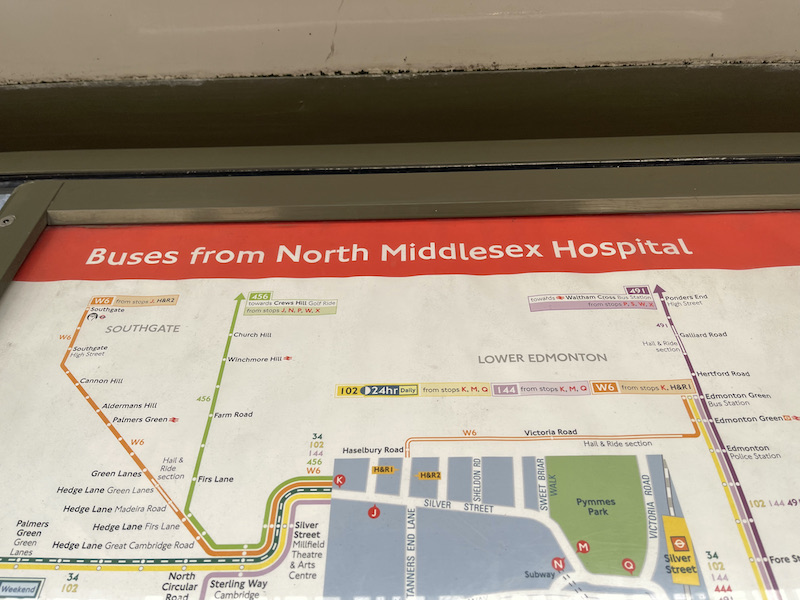
Readers may recall the Enfield to Crews Hill section of the route wasn’t new when the 456 began last March. It was introduced 30 years ago as route W10 albeit just as a limited off peak service.
But the new section of route seems to be doing reasonably well but its certainly not doing anything to help TfL’s finances, that’s for sure.
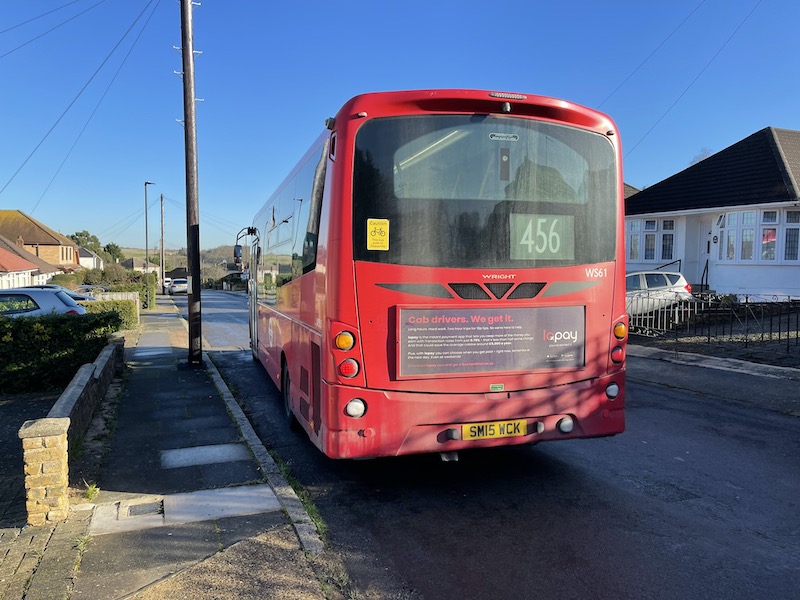
Neither is the 733.
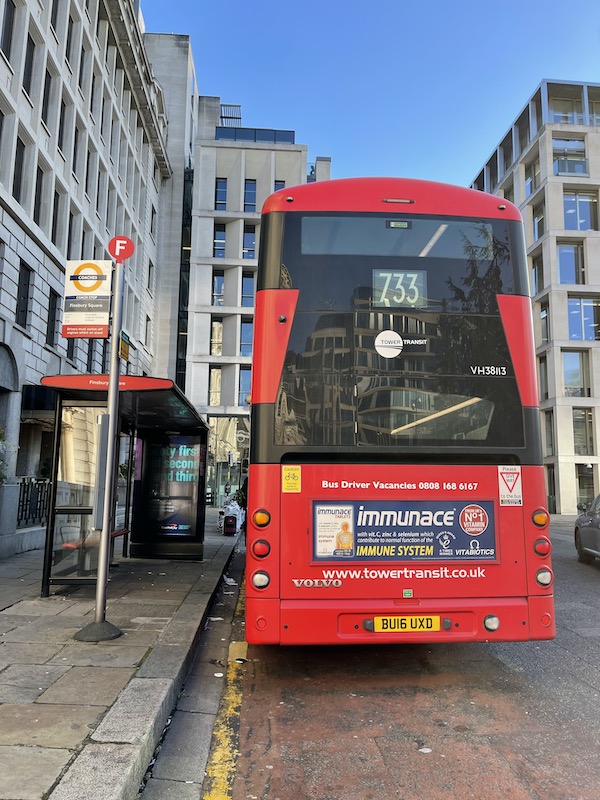
And I doubt I’ll be using “London’s newest bus route” as a title for a blog post again any time soon.
Roger French
Diamond Geezer has posted his usual erudite commentary, characteristically at 07:33, this morning which is well worth a read.
Blogging timetable: 06:00 TThSSu.
Next blog, Thursday 20th January: Maidstone’s Park & Ride to end.

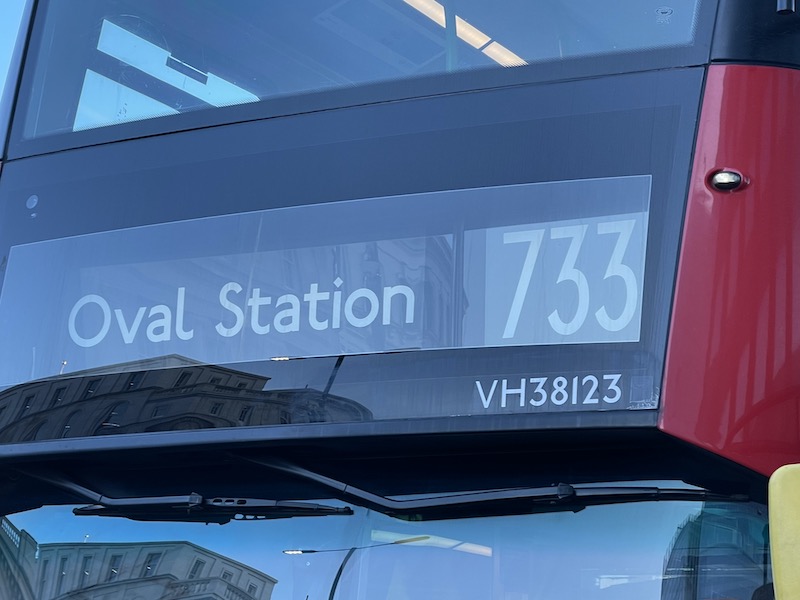
Why oh why do all TfL services have to be over-layered with excess running time? This is Central London in the middle of a pandemic, with traffic levels at almost historic lows. The 733 is an Underground replacement service primarily for displaced rail passengers, so I am sure they will all be delighted to enjoy “the Driver has been instructed to wait at this stop to even out the service……”. announcements on a daily basis.
Merely reinforces the conception that buses are the slowest form of transport and to be avoided at all costs. This need not be.
LikeLike
Thanks for the tour of Route 733. I think the buses may be from Westbourne Park garage, because the TfL notice mentions RATP. It might have been cheaper for Waterloo, Camberwell or Walworth to run the route – if staff are available there.
LikeLike
Bus services in London have to meet various targets . . . one of which is Excess Waiting Time. This is measured by the amount of time a nominal passenger may wait above the nominal frequency. So: a service every 10 minutes might have an EWT of 1 minute; if the service runs in excess of this it will receive a financial penalty. This is why bus operators pad out running times, so that the service has every chance of avoiding financial penalties.
It is also the case that TfL fail to provide adequate stand space at terminal points . . . so if the service runs through a traffic hotspot. the running time will also be padded out so that any delays do not “knock-on” to the next trip.
Operators have no interest in speeding up the journey, if in doing so they may incur more penalties . . . after all, TfL have agreed the PVR and staff costs in the initial contract; what business will voluntarily give up part of their income??
TfL’s attitude to the passenger through all this is “by buying a ticket you accept our conditions of carriage; that includes the timetabled journey time. If that means the journey is slow, so be it”. Obviously I paraphrase this, but you get the gist.
This is what happens when the LTA contracts out the operations, and has to monitor said operations to ensure they get what they pay for. Contracts are monitored continuously (every time a London bus passes a timetable point, a measure is taken of the “schedule adherence and EWT”, and penalties levied if non-compliant). The passenger’s needs go some way down the list of priorities.
All those passengers who live in Greater Manchester and Tyne and Wear . . . be careful what you wish for!!! “Franchising” doesn’t necessarily always benefit the passenger.
LikeLike
The reasons why are fully understood (running times), and merely underline that those responsible for planning at TfL clearly have no clue about how buses are actually operated. Let us hope and pray some are never tempted to move their “expertise” beyond London. And certainly agree that the Passenger features some way down the line.
LikeLike
Most London buses are high frequency so are controlled to try to keep them equally spaced so having excess stand time seems a little daft. Quite why TfL should penalize a company if a bus is 1 minute later who knows. Is a bus being 1 minute late going to have any serious impact on passengers ? and given London traffic how practicable is that any way
TfL could save a lot of money with more sensible scheduling. With modern technology as well you should no exactly where every bus on a route is and you should know where the current congestion problems are on a route
LikeLike
TfL seem to like to waste money. Why an earth do they need to have someone standing at the bus stops ?
Do they need so many buses on the route they seem to be running around half empty. They may need to look at that after the first week. I suspect off peak they will not get many passengers and because for some strange reason it i serving all bus stops it may well just be picking up passengers that normally used another route
LikeLike
Timetable is too tight – Causes late running, so everyone moans about it and slates them for being delayed.
Timetable padded out a bit – Buses sitting around, so everyone moans that the service is too slow.
It seems that TfL cannot win either way…!
LikeLike
‘Change at Angel’ – Moorgate is an interchange station and the Northern line trains are terminating and reversing from the same platform, which is narrow for the number of people going to and fro. Angel is not an interchange – people just either enter or exit and people entering can be held outside at street level if needed to control numbers inside, with no need to non-stop trains on other lines too, like there would be at Moorgate. It also has very wide platforms. Best to get people out of Moorgate on the first train and wait for a train to their destination on the wider platform at a quieter station. It means Moorgate is less likely to be disrupted when it is busy.
LikeLike
The fare penalty point is a good one – especially as everybody just touches in so may not really check what fares are charged. It is a useful reminder to those of us from outside London that the much talked about “hopper” fare which you may think allows cross-TfL changes in the hour doesn’t apply to all modes, just bus and tram. As a dedicated rail replacement service I’d have expected a stations only stopping point. If the intermediate stops away from stations needed an extra service then it would be a permanent change and not just until May. Perhaps the drivers get fed up being flagged down when the bus looks just like any other
LikeLike
Ian comments that the route is run by RATP. No, TfL just don’t know who runs it and have got it wrong.
LikeLike
Test
LikeLike
Roger, your nrw style blog is very difficult to post a comment on, at least on smart phones aa you are typing white letters on to light yellow background, is there any wat to change that
LikeLike
That’s a good point; many thanks. I’ll take a look at the options available.
LikeLike
Have managed to work out how to change the default colour background and hopefully the darker shade now overcomes the problem of the white type when using a smartphone to reply. Thanks for raising this.
LikeLike
It is LUL policy not to run rail replacements in zone 1.
There have been exceptions, like Paddington to Hyde Park Corner, for specific reasons, but therefore the 733 is not a rail replacement as such. I raised the fact that people have to pay extra bus fares, and the reply was that almost all journeys can be made by other tube lines, but anyway the conditions of carriage say they do not have to provide any replacement buses for line closures.
LikeLike
On the first day of the closure, the poster at Oval was telling people to go to the wrong bus stop for the 733
LikeLike
I can understand thr logic of getting people to Angel to wait for their correct train, but people aren’t going to do that, as it will reduce their chance of getting a seat to virtually nothing.
LikeLike
Yes, some people want a seat all the way, but others aren’t that bothered, especially if their trip is relatively short and others with longer journeys know that as the jiourney progresses, more seats become available – for example where many might exit at Kings Cross or Euston and they can nab a seat there before more board from the platforms.
I suppose if the platform at Moorgate becomes crowded and they have to start holding people outside or non-stopping other services, that will reduce their chance of getting a train. I think most people value the predictablility of their commute, knowing how long it will take and that their chosen route is going to be available every day and will reject options which consistently fail to deliver that in favour of ones which offer better certainty. I guess as more people return to the office they’ll make their own choice about the toss up between getting a seat or not being held outside and not getting a train. Quite often it only requires a relativekly small % of people to choose to change their route for problems to ease, so if enough people make the Angel choice then the issues at Moorgate might not materialise. Obviously not everyone is going to follow that advice, but i doubt everyone would need to.
LikeLike
Crossrail
A provisional opening date of Marchfor opening the Central section has now been set but Bond Streert will not open then.
The Consultants are concerned that TfL are rushing this and they are risking delying the full opening of Crossrail
LikeLike
I at last had the opportunity this afternoon to travel on the 733 with my young grandson on one of our expeditions. We left Oval about 1400 and, until London Bridge, picked up no more than a dozen people, very few of whom went any distance. Following the changes to the timetable, with faster running time, we moved at some pace. This was enhanced by the driver working on the principle that unless people were actively waiving their hands at stops he wouldn’t even slow down.
With the exception of north of London Bridge the 733 merely duplicates the 133. People who are going to the affected Northern Line stations do, with the exception of Borough, have the option of using other lines to get to their destination. One has to wonder quite what the 733 is supposed to be there for given that it is not working as a rail replacement service.
LikeLike